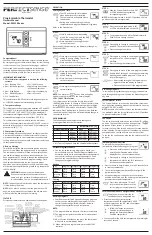
2800 Laura Lane Madison, WI 53562 | 800.288.9383 Fax: 608.836.9044 | www.tcsbasys.com
27
animated, check the fan and system modes. If the fan is off but the fan symbol is animated, check wiring. Connect a
jumper between the “R” and “G” terminals to see if the fan comes on. If the fan comes on, the relay in the thermostat may
be faulty, or programming is incorrect. If the fan does not come on, check unit wiring to thermostat.
6.2.3 Heating or Cooling Does Not Come On
When the heating symbol is shown, at least one stage of heating is on, or an analog output is modulating for heat. When
the cooling symbol is shown, at least one stage of cooling is on, or an analog output is modulating for cool.
If the heating or cooling is not coming on, but the thermostat is calling for heat or cool respectively, this is most likely
a wiring issue. Check equipment wiring. Place a jumper across terminals “R” to “W1” and see if the heating comes on.
Place a jumper across terminals “R” to “Y1” and see if the cooling comes on. This is to check for a mechanical relay
failure.
If you feel that the heating or cooling should be on, but the corresponding symbol is not visible, check the following:
•
System Mode
•
Heating and Cooling Setpoints
•
Offsets and Differentials
•
Room Temperature is above the Cooling Setpoint or below Heating Setpoint.
•
Outdoor Air Lockout Status
•
Discharge Air Limit Status
6.2.4 Wrong Temperature Display
The temperature displayed on the screen is the temperature that is used to control heating and cooling. If this
temperature reading is incorrect, the thermostat will not control properly.
If using the internal temperature sensor, check the calibration
(see section 4.5.2.2)
.
If using a remote temperature sensor on the T1 terminals, check the room temperature source screen in the advanced
settings to verify programming
(see section 4.5.2.3)
If the temperature reading is only slightly off, check calibration
(see
section 4.5.2.2)
. Otherwise, use the system test mode screen to verify ohm readings of the temperature sensor
(see
section 4.5.2.10)
.
6.2.5 Thermostat is Overcooling or Underheating
Overcooling or underheating can occur if the thermostat top is placed to close to an air vent, where air is allowed to enter
the thermostat and cause erroneous temperature readings. To fix this problem the air stream from the vent will need to
be redirected, or the thermostat will need to be relocated, or a remote sensor could be used.
Overcooling can also happen if the thermostat is mounted in direct sunlight. In this case, the thermostat will need to be
relocated, or a remote sensor will need to be installed.
Overheating or undercooling can occur when air is allowed to flow into the thermostat from within the wall. If this occurs,
seal the wall where the wires enter the thermostat.
6.2.6 Service Status Symbol is Visible
This indicates the HVAC Equipment requires service.
See section 4.3
for more information on Service Status.
6.2.7 Outputs Will Not Shut Off
First check the room temperature and the setpoints and determine whether the output should be on. There are delays
and minimum on and off times for the fan and heating and cooling stages. Also, check the status screen to verify that
the outputs are on. If the heating or cooling outputs are shown to be on, programming will need to be verified. If the
heating or cooling is shown to be off, the relays will need to be verified for proper operation or wiring will need to be
checked. Turning the system mode to “Off” (Settings>System Mode) or resetting the thermostat will instantly turn all
outputs off. The thermostat can be reset by touching and holding the status button for five seconds. Note that polarity
of the relay outputs can be reversed such that the relays are Normally Closed. This causes the state of the relay to be
closed (energized) when the status is “Off” and open (de-energized) when the status is “On”. The polarity can be changed
using Ubiquity
TM
or a third party BACnet configuration tool.
CHECKOUT
AND
TROUBLESHOOTING
















































